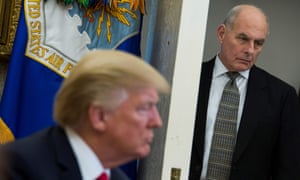Extract from The Guardian
- Retired general gives interview to Los Angeles Times
- Statements on immigration and more likely to anger president
As Donald Trump attracted criticism for blaming the deaths of children
in US custody on Democrats opposed to his demands for a border wall,
outgoing White House chief of staff John Kelly said he had “nothing but
compassion” for migrants attempting to enter the US without
documentation.
“Illegal immigrants, overwhelmingly, are not bad people,” Kelly said,
describing many migrants as victims misled by traffickers. “I have
nothing but compassion for them, the young kids.”Two young Guatemalan children have died in US custody this month. Amid debate, the causes of death remain unknown.
Kelly, a retired Marines general, spoke in an interview with the Los Angeles Times conducted by phone on Friday and published on Sunday morning. He will leave the White House on Wednesday. His remarks, jarring with those of the president, echoed those of his successor as homeland security secretary, Kirstjen Nielsen, who visited the border this weekend.
In a statement released around the same time on Saturday that Trump tweeted that “any deaths of children or others at the border are strictly the fault of the Democrats and their pathetic immigration policies”, Nielsen said: “The system is clearly overwhelmed and we must work together to address this humanitarian crisis and protect vulnerable populations.”
Nielsen also called on Congress to “act with urgency”. That is unlikely during a standoff over funding for Trump’s wall which has now led to a nine-day government shutdown.
Trump
On Friday, Trump tweeted a threat to “cut off all aid” to Honduras, Guatemala and El Salvador for “doing nothing” about migration to the US and “taking our money”.
The chief of staff criticised the implementation of the family separations policy at the border, which in the summer “brought down a greater deal of thunder on the president”.
Of Trump’s demanded wall, for which he has shut down the US government despite campaigning on a promise to make Mexico pay, Kelly said: “To be honest, it’s not a wall.”
“The president still says ‘wall’,” he said. “Oftentimes frankly he’ll say ‘barrier’ or ‘fencing,’ now he’s tended toward steel slats. But we left a solid concrete wall early on in the administration, when we asked people what they needed and where they needed it.”
Citing the thorny question of withdrawing troops from Afghanistan and Trump’s urge to pull out of Nato, the Times said Kelly “defended his rocky tenure, arguing that it is best measured by what the president did not do when Kelly was at his side”.
Kelly was one of the so-called “adults in the room” – many of them generals, who supposedly restrained Trump’s worst impulses. Another, defense secretary Jim Mattis, will also leave on 1 January, his resignation over the withdrawal from Syria brought forward by a president piqued by the favourable media attention it gained.
Trump has chafed at media accounts of experienced aides acting to calm his wilder behaviour. In September, in his bestselling book Fear, the veteran reporter Bob Woodward wrote that Kelly called Trump an “idiot” and said working for him was like working in “Crazytown”. Trump responded angrily and Kelly denied the quotes.
Telling the LA Times his was a “bone-crushing hard job”, Kelly echoed recent comments by fired secretary of state Rex Tillerson, who said Trump regularly pushed the limits of his authority under law.
The paper wrote that “Trump never ordered him to do anything illegal, Kelly stressed, ‘because we wouldn’t have’.” Kelly told the paper that “if he had said to me, ‘Do it, or you’re fired,’” he would have resigned.
In the end, after a succession of reports of infighting and arguments within a chaotic White House, Kelly did resign. He told the paper he decided to go after the November midterm elections, in which Republicans lost control of the House. Trump announced his departure on 8 December.
Amid near-meltdown at the White House, no permanent replacement has been named. Kelly was asked why he stayed 18 months. He said it was down to duty.
“Military people don’t walk away,” he said, two days before walking away.

















